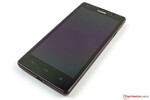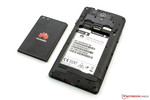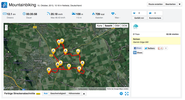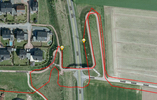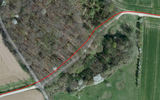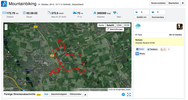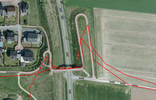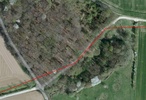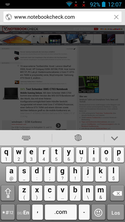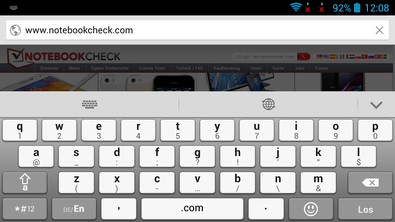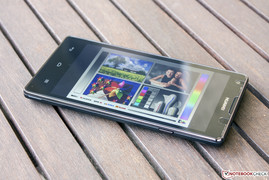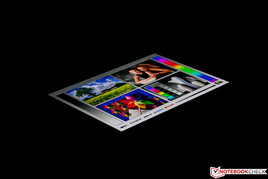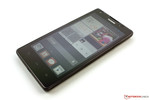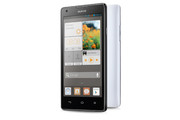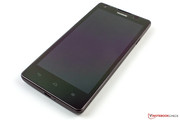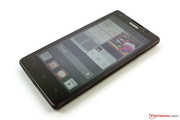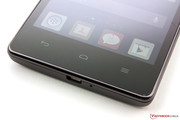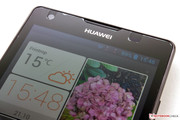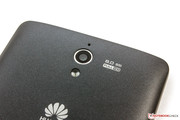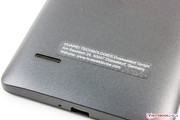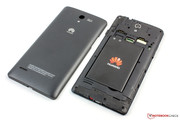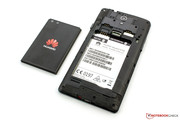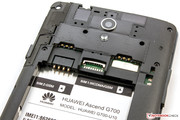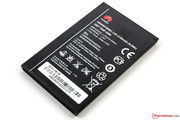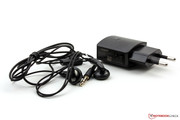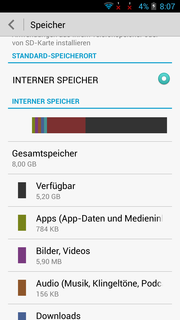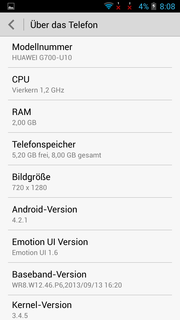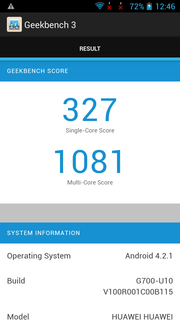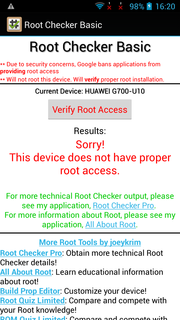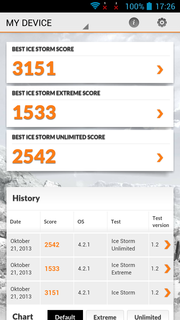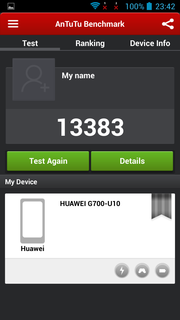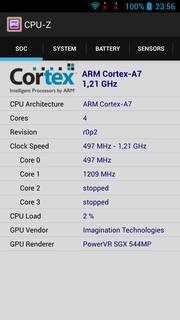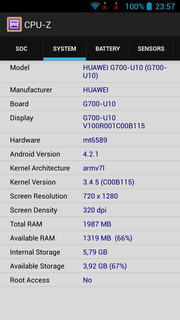Review Huawei Ascend G700 Smartphone

For the original German review, see here.
With the Ascend G700 Huawei offers a dual-SIM smartphone that is between entry and medium range. It has a high resolution IPS touchscreen as well as a strong chip with four cores. The memory bank is also quite large with 8 GB and can be extended via the card slot.
The G700 performs better than the Ascend G525 and also better than the competitors like the Acer Liquid E2 Duo and the iOcean X7. The HTC Desire 500 and the Nokia Lumia 720 are both in the same price range and, therefore, they can be considered as serious competitors. Our test reveals whether the smartphone from Huawei has a chance against the competition.
The Huawei Ascend G700 is made mostly out of plastic. It measures 142.5 x 72.8 x 8.95 mm and weighs 157 grams. So it is not part of the lightest smartphones, but is quite large due to its big touchscreen.
The display does not consist of a very scratch proof material, but is sealed with a protective foil by the manufacturer. This is well attached and does not cause any blisters, but it came off a bit on the edges of the test device. Also, the foil is extremely prone to fingerprints.
A metal frame surrounds the panel and connects it with the back side of the case. The back is made entirely out of plastic. Touches on the surface there also quickly leave lasting impressions. The haptics of the surface of this smartphone is very comfortable though and it lies well in the hand. The device is also very sturdy and nothing creaks. The back cover is fixed into place, but can be removed in order to gain access to the battery, the SIM slots and the MicroSD slot. Overall, the G700 leaves a good impression.
The equipment of the Ascend G700 does not come with any surprises. The MicroUSB 2.0 port serves both to charge the device as well as to transfer data to a computer. It is not possible to connect any external drives and MHL is not supported either, but it is DLNA capable.
The integrated MicroSD card reader accepts memory cards of up to 32 GB (SDHC).
Software
The operating system in use is Google's Android 4.2.1. It is enhanced by Huawei's own Emotion UI 1.6 interface. This consists mostly of optical adjustments, but they are neat and extend Jelly Bean with some useful widgets.
It is good to see that the Chinese manufacturer did not include any bloatware. Instead, there are some really useful apps preinstalled, such as the free Kingsoft Office and other sensible tools.
Communication & GPS
The Huawei Ascend G700 has two SIM slots for Mini-SIM cards. Both of these slots support triband GSM (900, 1800 and 1900 MHz), however, only one supports the fast HSPA+ standard (HSDPA: up to 42 MBit/s, HSUPA: up to 11.5 MBit/s) which also grants mobile internet access for the smartphone. Unfortunately, the coverage of frequencies is not very broad: only the 900 and 2100 MHz bands are supported. It does not have LTE. At least the G700 is still much faster than its little sister model the G525 (max. 21 MBit/s) or the iOcean X7 (max. 21 MBit/s).
The G700 can connect to the home network via the built-in Wi-Fi module. It supports the IEEE 802.11 standards b/g/n and sends in the 2.4 GHz band. The reach of the component is only mediocre. The device reached full signal only rarely even when placed right next to the router (Fritz!Box 6360). At a distance of 20 meters from the router there were still two bars visible in the task bar, but the loading process of the pages in the browser was extremely delayed and very slow.
The connections to GPS satellites are built up very fast with a good signal quality. Even indoors the position of the smartphone is determined quickly. In our comparison test the navigation device Garmin Edge 500 did not perform that well; neither the distance nor the speed were determined correctly.
Telephone functions and speech quality
The call app is more or less the same as the standard call apps, but was improved a bit in terms of look. At first we were looking for the button that allows activating the speaker, since the label "Audio" can be a bit misleading.
The speech quality is pretty good. People understood us well when holding the speaker right next to the ear. When there is a sound in the background it is filtered out, but in turn this also creates a little background noise. Calls via the loudspeaker also work well. Our interlocutor was not quite loud enough in both cases, however, this did not bother us in environments with normal background noise. Calls through the included headset caused a certain distortion of the interlocutor, but the microphone worked without any problems. Overall, the phone acoustics of the G700 are fine.
Cameras & Multimedia
The main camera has a resolution of up to 8 MP (3264x2448 pixels, aspect ratio 4:3). When 16:9 is preferred, then the resolution is reduced to 6 MP (3328x1872 pixels). The light sensitivity can also be regulated manually between ISO 100 and 800 with four levels. In dark environments an LED light supports the optics.
The camera can take formidable pictures in daylight. Although it does not quite reach the sharpness of an iPhone 5 or Lumia 920, it still delivers satisfactory results. The colors give the right impression. However, considering the price class of the device, this is really tolerable. However, in darker environments the optics are quickly overstrained. The photos do not look very sharp on the edges and fairly dark.
The webcam (1.3 MP: 1280x720 pixels) of the G700 has managed to surprise us in a good way. The camera is very good for video conferences and gives good results even in somewhat darker environments.
Accessories & Warranty
The accessories of the Ascend G700 include a modular power supply (5 V, 1 A), as well as a USB cable to connect the smartphone to the computer or to the power supply. Furthermore, there is also a headset, a fast-boot manual, and the warranty included.
Huawei grants 24 months of warranty on the device. Battery and charger both get a six months warranty, the headset only three.
Input & Control devices
The 5-inch capacitive touchscreen recognizes up to 10 touches simultaneously. It reacts quickly to inputs even when pressing almost at the edges. The physical buttons to turn on the device and for the volume control also work well, as well as the three Android sensor buttons on the screen. Besides the mandatory Return and Home buttons, there is also a Menu button.
The virtual keyboard received its own Huawei layout. It spreads out the different buttons nicely and is well made. The buttons are sufficiently large enough even in portrait view thanks to the big display, and the keyboard leaves enough space to still be able to see all of the content on the screen. The input device is more dominating in the landscape format and covers the largest part of the panel.
The display of the Huawei Ascend G700 is very bright and gives a resolution of 1280x720 pixels (HD). We measured a very good maximum brightness of 562 cd/m². The illumination is very uniform with 92%. These are very good results given the price range. Only the Blackberry smartphones are even brighter, e.g. the Z10 (max. 706 cd/m², 84%). Even the very bright Android flagship, the Sony Xperia Z1, only reaches maximum values of 523 cd/m².
| |||||||||||||||||||||||||
Brightness Distribution: 92 %
Center on Battery: 562 cd/m²
Contrast: 803:1 (Black: 0.7 cd/m²)
ΔE Color 4.56 | 0.5-29.43 Ø5
ΔE Greyscale 6.48 | 0.57-98 Ø5.3
Gamma: 2.83
The black value of the G700 is somewhat high at 0.7 cd/m², but even when looking at a very black picture this is not really bothersome. Only when looking really closely can one recognize the color as anthracite. The contrast ratio of 803:1 is good.
The panel calibration by the manufacturer is not quite as good as in many other top smartphones, but is fine. Visible color deviations cannot be seen or only by the trained eye. The critical line of dE 10 is not reached in any of the measurements. However, in the grayscale one can notice a green cast, which eats into the otherwise good impression overall.
Very bright and a great contrast ratio are good ingredients for a smartphone that can also be used outdoors. Our test has confirmed this. The brightness sensor also works well outdoors and quickly adjusts the brightness of the panel depending on the environment. When in the shade, one won't notice any difference to indoor use. Even in very bright environments the display is still readable without a problem. Only direct sunlight can be too much for the device. However, this is mostly due to the glossy properties of the panel.
The viewing angle stability of the Ascend G700 is great. Thanks to the IPS technology even extreme viewing angles do not impose any problems for the device. We did not see any changes in color either. Only the glossy surface can decrease the angle a bit.
The built-in chip is a MediaTek MT6589. The CPU has four cores with up to 1.2 GHz each. 2 GB RAM is great as it is rare in this price segment. The graphic unit of the SoC is a PowerVR SGX544MP that operates at 200 MHz.
The CPU delivers good results in the benchmarks and is on par with the Acer Liquid E2 that also uses the same SoC. However, the graphics performance is a bit lower and cannot keep up with the HTC Desire 500 (Adreno 305). The power of the G700 gives a good impression in daily use. It needs some time after the start, but afterwards it runs very smoothly.
| 3DMark - 1280x720 Ice Storm Standard Score (sort by value) | |
| Huawei Ascend G700 | |
| HTC Desire 500 | |
| Huawei Ascend G525 | |
| Acer Liquid E2 v370 | |
| GFXBench (DX / GLBenchmark) 2.7 | |
| T-Rex Onscreen (sort by value) | |
| Huawei Ascend G700 | |
| HTC Desire 500 | |
| Huawei Ascend G525 | |
| iOcean X7 | |
| Acer Liquid E2 v370 | |
| Samsung Galaxy S3 | |
| 1920x1080 T-Rex Offscreen (sort by value) | |
| Huawei Ascend G700 | |
| HTC Desire 500 | |
| Huawei Ascend G525 | |
| iOcean X7 | |
| Acer Liquid E2 v370 | |
| Samsung Galaxy S3 | |
| Geekbench 2 - 32 Bit - Total Score (sort by value) | |
| Huawei Ascend G700 | |
| HTC Desire 500 | |
| iOcean X7 | |
| Acer Liquid E2 v370 | |
| Samsung Galaxy S3 | |
The G700 leaves somewhat mixed impressions in the browser benchmarks that we performed with Google Chrome 30. It leaves all its competitors clearly behind in the Google Octane V1 benchmark, but in Browsermark 2.0 the direct competitor from Acer performs much faster. However, in daily use such differences will almost never be noticeable.
| Peacekeeper - --- (sort by value) | |
| Huawei Ascend G700 | |
| Huawei Ascend G525 | |
| HTC Desire 500 | |
| iOcean X7 | |
| Acer Liquid E2 v370 | |
| Octane V1 - Total Score (sort by value) | |
| Huawei Ascend G700 | |
| Huawei Ascend G525 | |
| HTC Desire 500 | |
| iOcean X7 | |
| Acer Liquid E2 v370 | |
| Browsermark - --- (sort by value) | |
| Huawei Ascend G700 | |
| Huawei Ascend G525 | |
| HTC Desire 500 | |
| iOcean X7 | |
There is not only more memory than in the G525, but it is also much faster, however, neither of them are top-notch memory banks. Hence, the result is about average in comparison to the competition. Only in sequential reading does the G700 score at the top. In the other sections the Acer Liquid E2 is at the top.
| AndroBench 3-5 | |
| Random Read 4KB (sort by value) | |
| Huawei Ascend G700 | |
| Huawei Ascend G525 | |
| HTC Desire 500 | |
| iOcean X7 | |
| Acer Liquid E2 v370 | |
| Random Write 4KB (sort by value) | |
| Huawei Ascend G700 | |
| Huawei Ascend G525 | |
| HTC Desire 500 | |
| iOcean X7 | |
| Acer Liquid E2 v370 | |
| Sequential Read 256KB (sort by value) | |
| Huawei Ascend G700 | |
| Huawei Ascend G525 | |
| HTC Desire 500 | |
| iOcean X7 | |
| Acer Liquid E2 v370 | |
| Sequential Write 256KB (sort by value) | |
| Huawei Ascend G700 | |
| Huawei Ascend G525 | |
| HTC Desire 500 | |
| iOcean X7 | |
| Acer Liquid E2 v370 | |
Games
The graphics performance of the Ascend G700 is not so good, but the mid-range GPU PowerVR SGX544MP still offers enough power for casual games like Angry Birds. Even the 3D titles that we tested all ran without any problems. However, the G700 reached only 23 fps in the Ultra High Quality benchmark from Epic Citadel. This shows that in games with high graphic requirements one does have to live with a certain lag.
The smoothness of the touchscreen that grants smooth gliding, and the very properly working sensors further add to the gaming compatibility of the test device.
Temperature
The surface temperature of the Huawei Ascend G700 is very low in idle mode: it reaches a maximum of 28.2 °C in a two hour run. Even under load it peaks at a relatively low value of 34.5 °C. Therefore, there is nothing to criticize in terms of temperatures.
(+) The maximum temperature on the upper side is 34.5 °C / 94 F, compared to the average of 35 °C / 95 F, ranging from 21.9 to 56 °C for the class Smartphone.
(+) The bottom heats up to a maximum of 33.3 °C / 92 F, compared to the average of 33.8 °C / 93 F
(+) In idle usage, the average temperature for the upper side is 26.8 °C / 80 F, compared to the device average of 32.7 °C / 91 F.
Speakers
The mono speakers produce a very treble-like sound, and the high frequency tones are distorted a bit when the device is set on loud. The medium and low spectrum is missing entirely. The bass can only be heard a bit as a rattle in the background. The quality of the headset is much better.
Power Consumption
The energy consumption of the Huawei Ascend G700 is definitely not very high. Despite the very bright display, the smartphone only consumes 1.5 Watts in idle mode. The consumption values rise to a maximum of 3.1 Watts under full load. The values are only better when the device is off or in standby.
| Off / Standby | |
| Idle | |
| Load |
|
Battery Runtime
The battery capacity is relatively high with a value of 8.2 Wh (2.150 mAh, 3.8 V). Together with low consumption values this leads to good battery runtimes. The G700 lasted almost four and a half hours in the stability test even when all power consumers were on and the display set at maximum brightness.
The Wi-Fi test is a bit more realistic for daily use. Here, the panel brightness is set at 150 cd/m² and a new website is opened every 40 seconds. Under these conditions the test device reached running times of almost 14 hours. This is truly remarkable. One can easily get through the whole day with a single battery charge. Also, the battery can be swapped easily.
Huawei presents a good smartphone in the mid-range with the Ascend G700. It has a very good price versus performance ratio. Furthermore, the display is really good and comes with a higher resolution than its direct competitor the Acer Liquid E2 Duo. Moreover, both the RAM and the flash memory have twice the size of the competitor. Then it does not hurt so much even if the memory is somewhat slower.
Given the price the only thing one can criticize are the mediocre speakers, the low-range Wi-Fi and the low coverage of frequencies of the mobile standards. People who like to surf the web a lot, and who do not absolutely need Android, should have a look at the Blackberry Z10 (from 265 Euros, ~$360) or the Nokia Lumia 920 (from 260 Euros, ~$353). Both these top smartphones have more power as well as the LTE standard. They have only one SIM slot though.


 Deutsch
Deutsch English
English Español
Español Français
Français Italiano
Italiano Nederlands
Nederlands Polski
Polski Português
Português Русский
Русский Türkçe
Türkçe Svenska
Svenska Chinese
Chinese Magyar
Magyar
